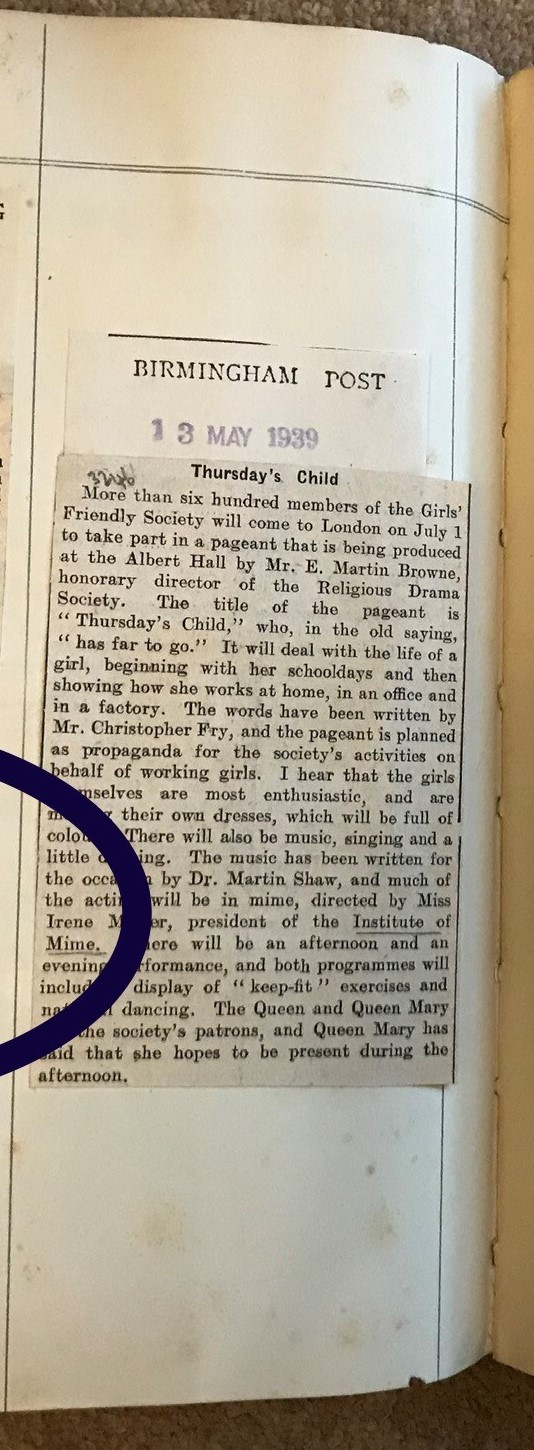Thursday’s Child (Part One). 13 May 1939
Thursday’s Child. 13 May 1939
Birmingham Post
In this news clipping, we learn of a forthcoming production called Thursday’s Child. I will write more fully on this in the future blog post which gives a review of the performance.
The show will be at the Albert Hall, in London on 1st July 1939 and will feature some 600 performers, largely untrained, and all female. This has come about because the show has been set-up by the Girls’ Friendly Society – an Anglican-based organisation who at this time offered help, mentoring, and in some cases shelter, to girls and women who were struggling at the lower end of the class system. Basically, the Society assisted working class girls and women by educating them how to protect themselves and giving them confidence. This would have been an ideal situation for Irene Mawer, who herself had attended an all-girls school and saw the power of educating girls.
Irene Mawer believed in the possibility of mime being used as an educational tool and part of the ethos of the Institute of Mime was to get this subject onto the school curriculum, into community groups and into schools for deaf children.
For the working class girls and women who took part in this show, it must have been a massively thrilling experience – in 1939, simply a day out to London would have been a major event in itself. On top of that not only to perform at the Albert Hall, but to have the possibility that Her Majesty Queen Mary might be there, too, would have been just out of this world. I think it is fair to say that for the majority of the participants, this show would have been the highlight of their lives to that point.
Although the Education Act of 1918 meant that girls could stay on at school until the age of 14, and the Sex Disqualification Act of 1919 technically meant that opportunities for women had improved, in reality it was middle class women who benefitted from the changes – and once they got married, the majority of women of all classes, did not work outside the home.
Housework, cooking, washing and childcare would have been the predominant occupations of women. Those working class women who did go out to work would do all of their own housework plus their paid job (most likely in a factory, or in a shop, or in domestic service). And remember – there were no washing machines or dishwashers in those days!
So Thursday’s Child would have represented colour and joy in their somewhat insular existence. There was music, and dancing, and singing (remember, these women may have had access to a radio but the cinema would have been a rare treat and definitely no on-demand Netfix). The show offered companionship of other people of their own age, a chance to talk about things apart from children and other peoples’ needs. These women are unlikely to have had much opportunity to undertake artistic training such as dancing, singing or acting, so the use of mime was a clever way to give them the opportunity to be on stage.
I imagine that it would have worked in the following way: the Institute of Mime was a co-ordinating body for teachers of mime anywhere in Britain (mainly in England), so Miss Mawer would have been able to disseminate her requirements through the Institute to the teachers of mime. In turn, the teachers presumably worked with groups of women who lived in the various localities, organised by the Girls’ Friendly Society. The content of the mime performances was based on showing what the girls and women did in their everyday lives: at school; at home; at work (eg, in an office and in a factory). In this way, the participants would have been acting out something that they were already very familiar with – peeling potatoes, sweeping the floor, making a bed, using a typewriter, packing boxes, etc. I expect that during rehearsals, the performers would learn basic mime exercises which would give control over their bodies, and also practice the occupations that they were going to demonstrate.
As I write this, I am really getting involved as to how I think the challenge would have been met. Coming from a working class background myself, I can really imagine that as a teenager I would have absolutely loved the opportunity to do this. There must have been so many girls who simply had few options other than marriage, babies and housework – and to rarely travel beyond their own local area.
Hurrah for the Girls’ Friendly Society (who, by the way, are still in existence today): https://girlsfriendlysociety.org.uk/what-we-do/our-history/
Irene Mawer worked hard to bring mime training to everyone (particularly women), hoping it would help give poise and increase confidence, and as an outlet for creativity. Please help more people to know about her by sharing/liking/commenting etc. Thank you.

